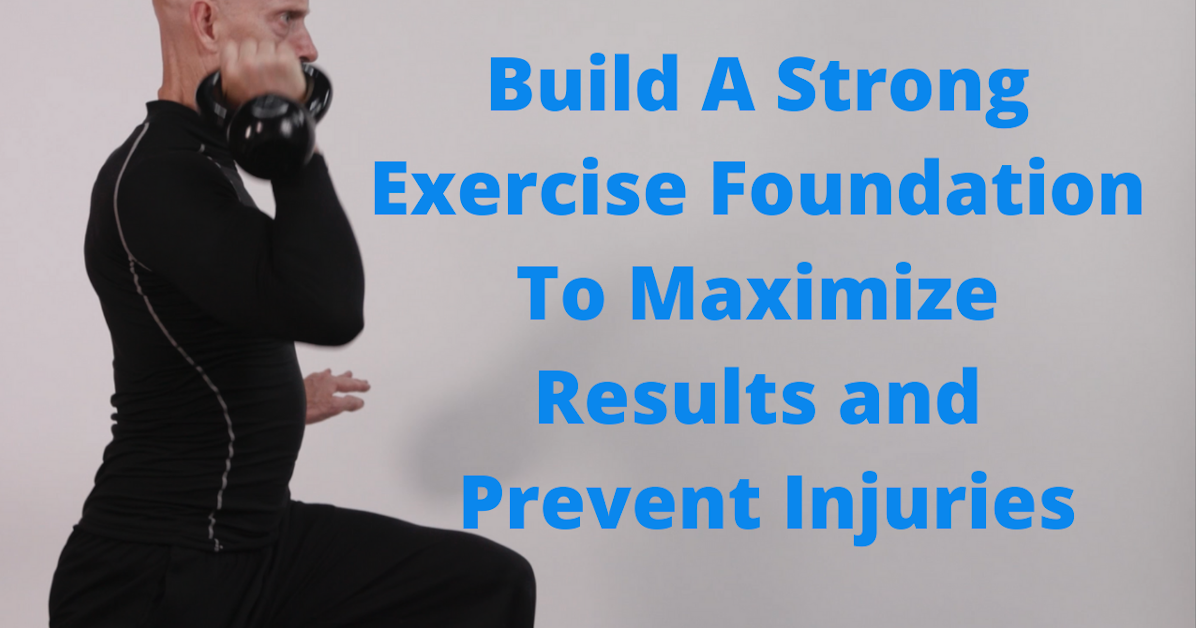How you can build a strong exercise foundation to improve your results and prevent injuries too early.
Why is it important to build a strong foundation and do the right types of exercises and the right type of programming?
Well, number one, and probably most important, it’s going to lessen your chances of an injury. Injuries can happen and there are certain things that we can do to minimize those risks.
Besides injury, it’s going to teach our muscles how to fire properly. If you’re firing muscles incorrectly, that can actually lead to poor results, a higher chance of injury, and not developing the muscles to their fullest potential. By learning how to perform movements correctly at the outset, we’re going to make greater improvements. Qualified personal trainers and instructors can help show you the correct technique and how to fire the correct muscles when performing strength training exercises.
Now that we know some of the reasons why – the first step when starting is goal setting.
(Watch the original video on YouTube here.)
Goal-Setting
Goal setting identifies what you’re trying to accomplish and this is key to building that strong foundation. When you have a goal in mind you then can outline the action steps necessary.
Assessments
In addition to goal setting – assessments are an integral part of building a strong foundation. Assessments look at things like strength, flexibility, cardiovascular exercise, and mobility. When we find our strengths and our weaknesses, we want to make sure that we incorporate exercises that are going to help us with our specific needs. So for example, if through doing some basic assessments, you determine that you have tight hip flexors – stretching and trigger pointing this muscle group will help improve areas needing improvement. In this case tight hip flexors can lead to back pain. So identifying those strengths and weaknesses we can then plan exercises designed specifically for you.
Prehab Exercise
Besides assessments, prehab exercises are a good idea. With strength training (and life for that matter) there are certain areas that are more likely to get hurt. Typically these include shoulders, lower back, and knees. To be proactive, we do what I call prehab exercises (I have also developed a video). I typically choose at least one exercise for the shoulders (i.e. external rotation), knees (i.e. glute bridge), and lower back (i.e. planks). Doing an exercise or two doesn’t take that long and will dramatically reduce the chance of an injury in those areas previously mentioned.
Common Mistakes at the Gym
In addition to prehab exercises, there’s common mistakes that are typical in the gym. The old adage “monkey see, monkey do” is all too common. One is adding weight too quickly.
Adding Weight Too Quickly
I know we all want to progress, get stronger/faster, and more cardiovascularly fit. Well, especially when it comes to strength training, we tend to add too much weight too quickly. So some rules of thumb are first make sure that you can perform exercises through a full range of motion and in good control prior to adding extra weight.
Overdoing It!
In addition to adding weight too quickly, we also often overdo it. So a lot of times people jump in, and they’re like, hey, if I’m not really sore the next day, then I didn’t do things right. And they start off and they’re doing multiple sets, and multiple exercises, and their body’s not quite used to it. Doing so could lead to excessive soreness, overuse ailments, and injuries.
Neglecting Stretching
Besides doing too much too soon another mistake is neglecting stretching and trigger point. These are going to keep you in the game, flexible, help prevent injuries from over-use, make you feel better and get results faster. If you’re not spending at least 5-10 minutes several days of the week you’re going to speed up your level of dysfunction. Watch most older individuals – they move/look stiff, they have limited range of motion, and they rarely play sports. Stretching and trigger point can really lead to improved quality of life.
Identifying Habits
In addition to stretching and trigger point, identifying habits is key to building a strong foundation. If you’re sitting at a desk all the time, that can be problematic. So I encourage people who have a sedentary job or typically sit, consider getting a standing desk. A standing desk can help keep you stay looser in the muscles that will help with back pain.
Forward Rounded Posture
In addition to looking at our activities of daily living, most Americans have forward rounded posture. This includes rounded shoulders and a head forward posture. To help prevent injuries this we want to strengthen the posterior chain (aka posterior muscles). An example of posterior strengthening is a row or lat pulldown. Strengthening our posterior muscles is going to help us with posture, injury prevention, and just healthier living.
Skipping the Plyometrics
In addition to strengthening those posterior muscles, we also want to really consider skipping plyometric exercises or dynamic exercises when we first start an exercise program. Plyometric exercises involve jumping, or bounding. Examples include jumping squat, box jumps or jumping lunges. While they can play a role in an exercise program, usually these high impact dynamic movements put more stress on your body, and they’re going to increase your chances of injury. So build a foundation first for a couple of months before starting a lot of plyometrics. Also just a quick note on plyometrics. As we age, our body is made of collagen and our collagen structures weaken. So doing traditional plyometric type activities in your 40s 50s, and beyond is something you may want to think long and hard about.
Follow these principles and you’ll be way ahead of the curve and reaching those fitness goals you’ve always wanted – you can do this!
Glen Carrigan
Freedom 4 Life Fitness

